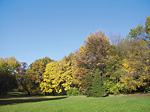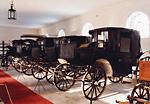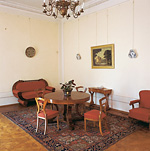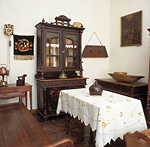Przeworsk and surroundings
Museum in Przeworsk The Palace-Park Complex of the Lubomirskis






The estate consists of a complex of buildings situated in the 12-hectare park: a palace, two outhouses, a guardhouse and a state gate, a greenhouse, a gardener house, a stable, a carriage-house with equerry house. In the building belonged to the complex, the Museum – The Palace-Park Complex takes place with exhibitions of palatial interiors, town and region history, history of firefighting, horse-drawn carriages and a room of temporary exhibitions, located in the former Palace’s kitchen.
The palatial complex, that origins date back to the first half of the 17th century, bought Princess Izabela Lubomirski from her daughters at the end of the 18th century. Later on, the Princess donated the Palace to her foster son Henryk Lubomirski. The Princess ordered to extend the existing late-Renaissance manor-house turning it into a small palace in the English-Classicism style. The refurbishment was carried out outstanding archtects of that epoch, employed by Lubomirska in Łańcut – Jan Griesmayer and Christian Piotr Aigner as well as a stucco decorator Fryderyk Bauman. The Palace, which was built in 1807, in the mid-19th century was extended according to the project of Feliks Księżarski. The building obtained a present architectural form. At the beginning and in the mid-19th the majority of buildings belonged to the complex were erected and a 17th century inn was rebuilt, that is situated opposite to the Palace buildings and a present international highway E-4.
From the beginning of the 19th century derives an arrangement of the park that origin dates back to the age of Romanticism, thanks to transforming the previous Italian garden. There are exotic trees in the park such as plate trees, tulip trees and also trees regarded as monuments of nature: oaks, lindens, ash trees, white pine trees, elm trees and hornbeams forming a unique alley.
By 1944 the Palace was a family seat of the Lubomirskis of the Przeworsk Estate. Its owners gathered priceless works of art, rich library and collections of numismatic objects, busts, ancient vases and national souvenirs. During the II World War and postwar period the collection was scattered. The largest part of exhibits was placed at the Castel-Museum in Łancut. Presently, in the Museum’s collection there is only a small part of old equipment of the Przeworsk Palace.
- Przeworsk
- The church and monastery of the Order of the Holy Sepulchre presently the Holy Spirit Parish Church
- St. Barbara Church and Monastery of Bernardines
- The Mother of God of Snow Church and Convent of Sisters of Charity
- Marketplace and Town Hall
- Museum in Przeworsk The Palace-Park Complex of the Lubomirskis
- The Open Air Museum – Inn “Pastewnik”
- The Tatar Tumulus
- The Narrow Gauge Railway Przeworsk–Dynów
- Sieniawa
- Kańczuga
- Zarzecze The Palace-Park Complex of the Dzieduszycki Family
- Siennów The All Saints Church
- Nowosielce The Maria Magdalena Church
- Markowa The Open Air Museum of Folk Buildings
- « Main page






